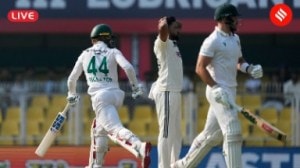Halfway house in loom town
You don’t have to read the looms to get to the bottom of this report card. Exactly a year after the abolition of the four-decade-old qu...

You don’t have to read the looms to get to the bottom of this report card. Exactly a year after the abolition of the four-decade-old quota regime for textile and apparel exports — a development that has opened up India’s biggest challenge, and opportunity, since the software boom of the early 1990s — it’s a halfway house.
Sure, India hasn’t fared badly in the past 12 months. The overall picture looks rosy — though, shockingly, there are no firm numbers yet, exports are estimated to have jumped around 15 per cent in 2005 to about $15 billion. This year is expected to be even better. The big firms are furiously investing in fresh capacities and product lines, their order books are overflowing, and the profit margins are healthy.
Problem is that the sector hasn’t performed spectacularly in 2005, either.
For a country that is expected to control 15 per cent of a $400-billion market in 2010, getting off the blocks with a bang would have been ideal. This hasn’t happened. Senior officials tracking the sector admit that India had been a slow starter, and practically lost the first four months of 2005.
While analysing the numbers for 2005, one must note that there is no consensus on the data dished out by the Directorate General of Commercial Intelligence and Statistics (DGCI&S). The official data shows that there has been a sharp decline in textile exports — spun yarn down 15.9 per cent in the first seven months of the year and fabric exports down 22.7 per cent.
Here, demand from Asia — UAE, Hong Kong, Sri Lanka, Bangladesh, Korea and so on — has slowed down. The region accounts for 40 per cent of India’s total textile exports. Domestic demand, on the other hand, remains robust thanks to higher garment exports. According to the DGCI&S, it is this performance in garment exports that has taken the overall growth figure for 2005 to 5-7 per cent.
Industry associations disagree. They say that based on import data from the US and EU — India’s largest customers — the exports growth is in the range of 15 per cent. Even associations admit that textile exports have shown a fall, but they aver that this has been more than compensated by good growth in garments exports, the country’s area of strength.
The truth, like always, lies somewhere in between. But one thing is obvious: it is India’s garment exporters — basically of cotton — that had reason to cheer in 2005. Thanks to low raw material prices over the past couple of years, as well as healthy demand, this segment is the crowning glory of the textile export story.
Here, in particular, a favourable zero-duty regime on cotton textiles, and measures like knitwear being moved away from the small-scale industry basket have really made a difference. However, there is worry that raw cotton prices could rise sharply on the back of some speculation on lower output in India and Pakistan. If so, this could dull India’s competitive edge.
Apart from raw material prices, an inherent problem with this strategy is an over-dependence on cotton, which may be abundantly available but also accounts for 70 per cent of India’s export basket.
In man-made fibres, India is losing out to Pakistan, Thailand, Indonesia and China. There have been strong demands for halving the excise duty on manmade fibres — polyester staple fibre, viscose staple fibre, and acrylic staple fibre — to 8 per cent. This should happen in Budget 2006 and improve viability and profitability of spinning mills. It would, more importantly, be a step in the right direction to change India’s product mix away from cotton.
Pricing pressures are a part and parcel of the garments trade as well. Most smaller garment exporters tell horror stories of how the Chinese super-engine is pricing them out of the market. An appreciating rupee through the large part of the year didn’t help matters, though this has reversed now much to the relief of exporters.
There are lessons to be learnt here — as well as opportunities. China’s unbridled success in the past year has led to restrictions on its exports to the US and EU. Some 48 items of Chinese exports are under quota to the US and EU till 2008. In many of these products — cotton yarn, bed linen, T-shirts, shirts, trousers — India has strengths as well as a great window of opportunity.
The big success of China is driven by quick turnaround times (manufacturing to delivery) as well as a flexible fibre base. All this basically is a function of superlative infrastructure. Industry estimates put Indian firms’ transaction cost — or the cost of doing business — as 10 per cent of the final export price.
To this one can add unrebated levies — like Octroi, Entry Tax, Electricity Duty, Sales Tax, Service Tax — which make up another 7 per cent or so of the final value. And then, of course, there’s the cost of power too — and the infrastructure burden remains immense.
Then there’s the oft-repeated issue of labour laws. Flexibility is a must here. The textiles sector is one of India’s largest employers, and is finding rigid labour laws a big weight. In fact, industry representatives say they are willing to double the offer to 200 days of guaranteed employment in the employment guarantee scheme instead of the 100 days on offer.
The good news is that, like China, India is now beginning to have the option of catering to a large, growing domestic market. The expansion of the retail market will open up fresh opportunities in 2006. As domestic brands grow, production will have to be sourced locally. That will be a significant inflexion point for the sector as the line between domestic sales and exports will blur.
Where India stands to gain is in smaller lots, and a wider range of products and design elements. There is also a strong move to building a fabrics base. Textile parks are in the works, and thanks to cheap funds from the Technology Upgradation Fund (TUF) scheme, Textiles Inc is investing in weaving machines, production lines and capacity expansion. These capacities will, alas, only come on stream by the middle of next year.
There is still a lot of ground to be covered — and quickly. Just four years ago, dyeing, printing, processing were all part of the small-scale sector. Now, as India is competing with the big boys for a share of the global textiles pie, being five years late in complete readiness is unfortunate. But that should increase the urgency to take full advantage of the immense opportunities.



- 01
- 02
- 03
- 04
- 05




























